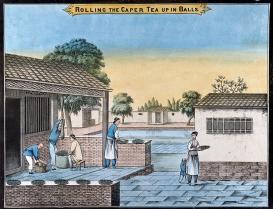by John Lourdusamy
Teascapes: Transfer and Transformations
In an important case of South-to-South transfer, tea (as a crop) was introduced into India, starting the 1830s from China. It was to be found later that tea plant as such was not new to India as a variant of it was found in Assam. But tea plants and most importantly the culture and knowhow of tea entered India from China in a big way in the 1830s. Tea would never be the same again as this transfer entailed considerable transformations on diverse fronts—the scale of cultivation, nature of ownership, mobilization of labor; methods of processing, marketing techniques, social reach, etc.
In China, tea was grown more like a household agricultural crop, cultivated on a small scale by independent peasant farmers except for a brief interlude in the eleventh century, under the Northern Song dynasty, when tea was a state monopoly and the government set up centrally-managed tea estates in the parts of Sichuan and Fujian. The plucking and processing was by and large manual.
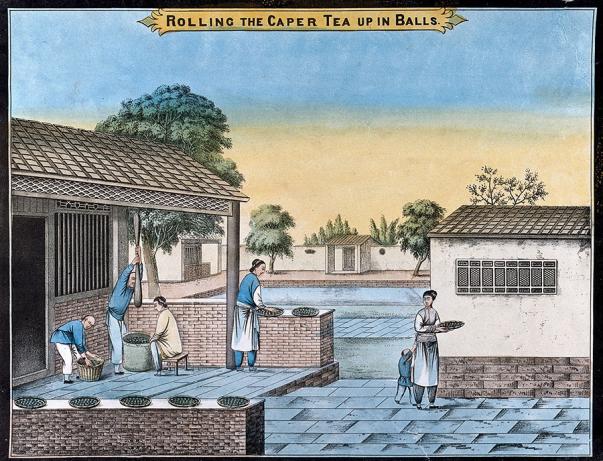
A tea plantation in China: Workers roll the caper tea into balls. Coloured lithograph.
Courtesy : Wellcome Trust Collection UK
When the British began to grow tea in colonial India, the cropscape that developed was radically different from the Chinese scenario. The cultivation of tea as a commercial crop entailed the creation of new places, as the plantations radically altered the virgin forests they replaced. The wild forests had to be "tamed" and brought to "fruitful" use. Through this work of civilizing the place, jungles were transformed into (tea) "gardens." The reconfigured cropscape involved "civilizing" not only the place, but also a local variant of "wild tea." Even as the EIC made efforts to transfer tea from China, a local variety of tea was discovered in Assam, in the north-eastern part of India. The variant had to be brought from the periphery of Assam to the new cropscape; from its "wilderness" to its new "garden."
The factors that prompted and facilitated this imagination and creation of new places are diverse. Tea as commodity was an important element of trade for the East India Company (EIC) since the early seventeenth century and EIC had a monopoly on that trade. However in 1833, the British parliament abolished the Company's monopoly over tea trade. This set the Company on the path of exploring possibilities of producing tea within India and setting India up as a new export springboard. Also with the availability of capital it could experiment with hitherto unexplored possibilities, including a strong ideal of mechanization, which took several decades to take full shape but was in complete contrast to the smallholder teascape. Most crucial in enabling these new teascapes was the colonial state, which facilitated the meeting of capital and crop through land allocation and help in transferring experimental farms. The emerging cropscape also included managing agents in Calcutta who mediated between British capital and the tea companies in Assam and the rest of India, and between the product and the consumer market.
Moving tea meant not only physical, botanical, and ecological changes, but also new social patterns and relationships in the new place. This in turn introduced another element of mobility: the bringing of families from the plains or far-off locations, to the new tea habitats. Thus the place was a new habitat both for the plant as well as for the people around the plant, whether owners, managers or laborers. The new cropscape was held together by a hierarchical system of management running from the white British manager to the indigenous laborer. The hierarchy was also reinforced in space, from the high-perched luxurious bungalow of the white manager to the ramshackle huts of the "native coolie lines." The new cropscape thus had its unique racial/spatial markings.
But this ordering went beyond just the human to encompass the realm of animals too and brought about significant reconfiguration of human-animal relations. Apart from uprooting and unsettling the fauna, teascapes involved other entanglements with animals. For instance, a recurring feature was the incidence of attacks by leopards and boars—entailing constant tension and vulnerability. These instances can be read as a desire on the part of the fauna to re-assert their own right to the place, and to interrogate or resist the new cropscape imposed on them by erasure of elements of their erstwhile habitat. In another example, waterlogging in the tea estates’ draining trenches introduced mosquitoes as an important element of the Assam cropscape.
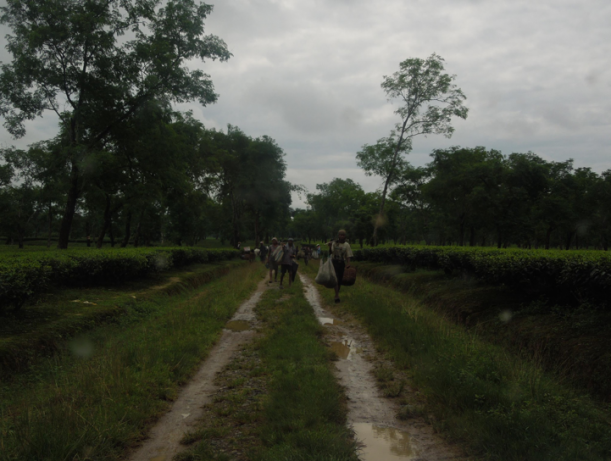
Photo by JBL (in a tea garden in Assam). The trenches by the side of the tea-plant bed collect excess water, but also turn into breeding grounds for mosquitoes.
Malaria and its fatal consequences introduced a further element of ferment and cruel dynamics in a place where labour forces perished and were constantly and with great difficulty replenished. The subsequent discovery of connections between mosquitoes and malaria brought further dimensions to the place-making in terms of the introduction of newer elements, such as the cinchona grown to combat the malaria menace. The new place was thus rendered a constant war-zone, precisely because of the very nature of the place-making mosquitoes against men; cinchona against mosquitoes; animals against men (and vice versa) and finally men against men (pathetic laborers trying to escape the horrors - malarial and managerial - of the new place and the management cruelly restraining them).
Looking beyond Assam, there are actually a range of teascapes across India. After tea’s successful introduction into Assam as a plantation crop, in yet another dimension of internal mobility, tea was trialed and successfully expanded to several other parts of India like Darjeeling (also in the eastern part of India), Kangra (in the North) and Nilgiris, Wayanad and Munnar (in the South). Each of these regions had different terrains and features, including elevation, climate, rainfall etc. Each bioscape thus produced corresponding variations. Mountain trains for instance formed an important part of the reconfigurations of cropscapes in hilly Darjeeling and Munnar plantations.
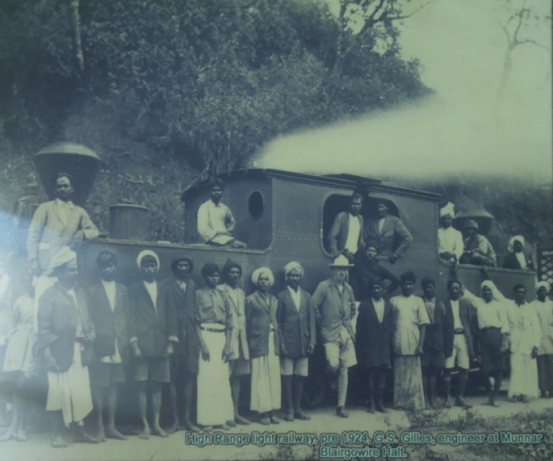
High Range Light Railway (pre-1924) Munnar, Munnar Tea Museum, Photo by JBL.
A hydro-electric power project, which could not be part of the Assam tea cropscape, formed an important part of the new cropscape of mountainous Munnar. This had other implications such as new options for energy and different ways in which resources could be allocated and things could be done. Also the creation of tea estates in hilly areas coincided with another variant of place-making: the establishment of hill stations (not seen in the Assam cropscape). The love and longing for the temperate homeland and its flora could be experienced to some extent in the cool climes of the hill stations. On the sidelines of the tea plantations, within the managerial bungalows, one could recreate the floral beauties and hedges that the white planters missed and longed for.
While all these places produced teas, the teas had different characters. The place defined the taste, influenced the demand and decided the right kind of market. The Darjeeling tea for instance was renowned for aroma while many of the southern Indian varieties were sought after for their strength. In course of time, the places also gave their names as Geographical Indicators ('Darjeeling Tea' for example) creating niche markets for them in the global trade of commodities. This is another remarkable exposition of how a crop makes the place in the sense of giving it a whole new identity. Tea gives an identity to its new place and gets another itself in turn. Again this identity is not in terms of its particular physical location alone but enunciated constantly by its inhabiting and spreading in the imaginations/mental images of men, and advertisement campaigns across different places - Darjeeling, the rest of India, London and the world.
Such entanglements (with other and far-off places) were an important feature of the tea cropscape. The plantation model, the technologies of processing and marketing large Assam-bush leaves into strong black teas to be drunk with milk and sugar, spread steadily throughout the spaces, races and classes of the British Empire.
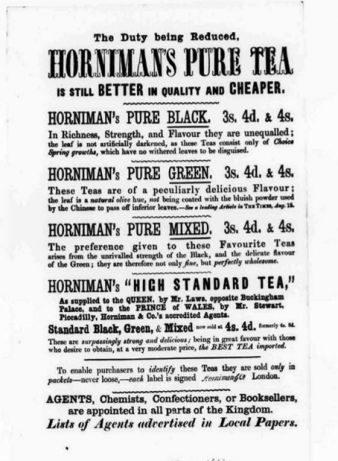
Upwardly-mobile young men from England and Scotland went out to manage tea-estates established wherever the ecology was deemed suitable, even beyond India—to Ceylon and then East Africa.
From a luxury for the rich, tea become the everyday beverage of the middle and then the working classes, first in the British Isles, then across the white-settler colonies and eventually among “natives” in India and other British colonies. Also, tea itself passed through several different places in its journey from a crop to a commodity. Unlike many other plantation crops like sugar or cotton, the processing in the case of tea happens very close to the growing field - within the very estate itself or in the nearest factory in the area. On the other hand, after it leaves the factory, and before it reaches its customers, it passes through hundreds to thousands of miles with much of its destiny as a commodity being decided at auction centers, which can be 100 miles from the tea field or 10,000. Blending centers are other important places which add meaning and value to the tea in transit. These distant places—some of which do not grow/produce an ounce of tea themselves—determine the fate of the tea as eventual commodity, as much as the place of its growth and processing. Hence, in spite of the remoteness of the self-contained tea garden, the fate of tea was shaped by multiple other places and processes.
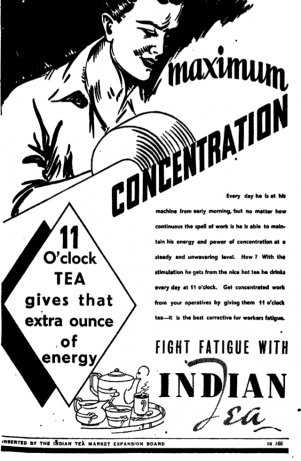
From: The Modern Review January 1942.
Thus a combination of socio-cultural zeal, new economic ambitions, new scientific/botanical studies and experiments, new means of acquiring labor, new managerial systems, financial arrangements (the managing agency system), mechanical innovations and social arrangements—all serving as multiple and inter-related constitutive factors that brought the cropscape into being and shaped the place, while the crop too was altered by the place. In the process, the cropscape acquired stability—a stability aligned to the desire and ambition of the colonial state and corporate interest.

